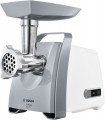Rated power
The power generated by the meat grinder motor during operation. The efficiency of work directly depends on the power: the greater the power, the more solid products the meat grinder is able to process and, usually, the higher the capacity (see Capacity). For most cases, a meat grinder with a power of 100 – 400 W is sufficient, however, for complex work with “heavy” products, more powerful devices are still required.
Rated is the power at which the device is able to operate for a long time without overheating, breakdown and other unpleasant consequences.
Peak power
Peak power is responsible for emergency situations, the device is able to work on it for a short time, however, long-term work with such a load is fraught with a meat grinder breakdown.
Loading tray material
The loading tray in modern meat grinders can be made of
plastic or
metal. Plastic trays are lighter and cheaper, but prone to scratches and discoloration over time, while more expensive metal trays are stronger and more durable.
Carrying handle
The presence of a handle on the body of the device, which allows you to easily move the device. This is especially true for heavy metal models that are regularly hidden in a closet.
Compartment for cord
A special compartment in the body of the device for storing the power cord. Often such compartments are also equipped with devices for uniform winding of the wire, which prevents bending and possible fractures.
The compartment for the cord is especially useful if the meat grinder is used relatively rare and has been idle for a long time outside the kitchen.
Legs with suction cups
The presence of rubber or silicone feet in the meat grinder design, installed in the lower part of the body.
The suction cup feet provide a strong grip of the device on the work surface, preventing it from slipping during operation, they also reduce vibration and noise. Thanks to this, the meat grinder maintains reliable stability, which is important when processing large volumes of solid products.

